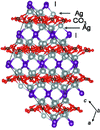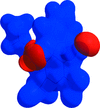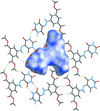issue contents
July 2021 issue

Cover illustration: Superionic conductors are an important class of materials that find a wide range of applications in batteries and sensors. Silver ion superionic conductors are of particular interest. These are based on α-AgI, which is synthesized from β-AgI (with a wurzite-type of structure). In this article, Suzuki and collaborators present the structure of a novel silver iodide carbonate, Ag10(CO3)3I4, which is a precursor of one of the only two iodide/carbonate-containing compounds reported so far in the ICSD, Ag17(CO3)3I11. The Ag10(CO3)3I4 compound reported in this contribution displays an ionic conductivity comparable to that of AgI-based arsenate and phosphate compounds. See: Suzuki, Watanabe, Yamane, Kitaura, Uchida & Matsushima [Acta Cryst. (2021). E77, 734–738].
research communications




































 journal menu
journal menu



































